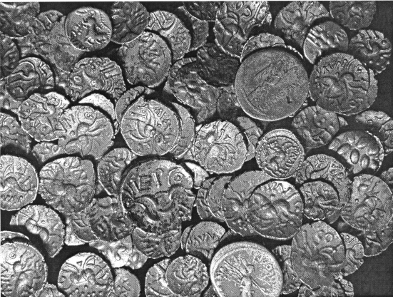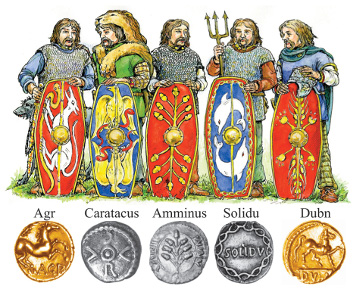Has Tom found Togodumnus?
by Chris Rudd
At 1.00pm on Saturday, 5 October 2013, metal detectorist Tom Lesurf, aged 19, found a small gold coin which raises a large question – a small gold coin which some of us believe was struck by a long-lost prince who died defending Britain again Roman invaders.
‘It’s the first gold coin I’ve found’ says Tom Lesurf, highways civil engineer. ‘I’d only been on the field for 15 minutes.’ Photo: Tom Lesurf.
Tom was taking part in a three-day rally on a farm at Bourne End, Bedfordshire, along with about 400 other metdets including his father Eddie Lesurf.
The gold quarter stater still in its clod of clay. ‘At first I thought it was a brass button’ says Tom, who was using an XP Goldmaxx Power detector. Photo: Tom Lesurf.
This is the first gold coin that Tom has found and it could well be the most important coin he will ever find.
CVNO/DVBN gold quarter stater, c.AD 43, ABC 3008. Only three others recorded. Found by Tom Lesurf at Bourne End, Beds., 5 October 2013. It was sold 13 January 2014 for 10,200 GBP. Photo: Elizabeth Cottam & Chris Rudd.
It is a 2,000-year-old gold quarter stater which was minted by a prince of the Catuvellauni (‘men excelling in battle’), probably around the time that the Roman emperor Claudius invaded Britain in AD 43.
The first three CVNO/DVBN quarter staters all came from Hallaton, E. Leics., only 35 miles from Bourne End. Cunobelinus minted coins at Camulodunon, Essex. Source: Elizabeth Cottam & Chris Rudd.
Only three other coins are known of this prince – all of the same type – and all three came from the huge Hallaton war-hoards in east Leicestershire – over 5,000 coins, mostly silver coins of the Corieltavi (‘army of the broad land’) – which could have been collected to finance resistance to the Roman advance into the East Midlands c.AD 45-46 and which were first discovered in 2000 by metdet Ken Wallace.
Some of the 5,000 coins from the Hallaton war-hoards, first discovered by Ken Wallace and valued at £458,000 by Chris Rudd. Source: British Museum news release 7 April. © The British Museum.
The big question is this: who issued Tom’s exceedingly rare gold quarter stater? At first glance this looks an easy question to answer. There are only two names (or rather, abbreviated names) inscribed on the coin – CVNO and DVBN. We know they must be regal names because only royalty minted gold coins in pre-Roman Britain and usually, I think, for military reasons: either to pay troops or to pay tribute money.
The first name is a doddle and beyond dispute. Cuno is short for Cunobelinus (‘hound of Belenus’) who apparently commanded the Catuvellauni of Hertfordshire, the Trinovantes of Essex and the Cantiaci of Kent for about three decades, c.AD 8-41. Cuno was top dog in southeast Britain and probably the most potent tribal king of his time – I’d say the most powerful in Atlantic Europe – who personally controlled more land, more lives and more wealth by AD 41 than any tribal leader west of the Rhine. Called Britannorum rex (‘king of the Britons’) by Suetonius (Caligula 44) and immortalised as Cymbeline by Shakespeare, Cuno is well known to history and certainly seems to have minted more gold coins than any other tribal king of his period; Derek Allen estimated that he struck over a million gold staters.
Gold stater of Dubnovellaunos, ABC 2392, struck at Camulodunon. He was deposed by Cunobelinus, c.AD 8-10, and is unlikely to have struck the CVNO/DVBN quarter staters. Photo: Elizabeth Cottam & Chris Rudd.
The other name on Tom’s coin is more difficult, more contentious. It’s the only instance where both names – CVNO and DVBN – occur on the same coin. This is puzzling because these two individuals have previously been considered to be tribal rivals, if not mortal enemies. Let me explain. Until seven years ago it was generally imagined that the DVBN inscription on the three Hallaton quarter staters referred to Dubnovellaunos (‘world ruler’) who was king of the Cantiaci and Trinovantes for maybe 15-20 years, c.10 BC-AD 10, until – and this is the crucial point – he was apparently deposed by Cunobelinus. This interpretation of DVBN was proposed by British Museum experts, Dr Jonathan Williams and Richard Hobbs, author of British Iron Age coins in the British Museum (BMP 1996), and not surprisingly has remained the widely accepted view, though more recently Dr Ian Leins, curator of Iron Age and Roman coins at the British Museum, has conceded that Dubn ‘may refer to a later, unknown ruler of the same name’ (Hoards, Hounds and Helmets: A conquest-period ritual site at Hallaton, Leicestershire, ed. Vicki Score, University of Leicester, 2011).
With respect to my distinguished colleagues at the British Museum, I’m sceptical, deeply sceptical. I don’t believe for one moment that the CVNO/DVBN quarter staters were struck by Cunobelinus. I don’t believe that they were struck by the Dubnovellaunos who was making money in Essex and Kent around the time Jesus was born – undoubtedly the Dumnobellau[nus] cited in the Res Gestae of Augustus c.AD 13. And I don’t believe that they were struck by ‘a later, unknown ruler of the same name.’ My disbelief is founded upon six observations:
1. Stylistically the CVNO/DVBN quarter staters don’t fit into Cuno’s regular gold coinage. The ear of corn is composed of three rows of grains, not the usual two rows; there is an exploding poppy head each side of the corn ear; and there is no palm branch above the horse, like there is on Cuno’s other gold coins.
Dr John Sills thinks the CVNO/DVBN quarter staters were issued after the death of Cunobelinus, the most potent tribal king of his time. Bronze unit, ABC 2957. Photo: Elizabeth Cottam & Chris Rudd.
2. Dr John Sills, author of Gaulish and early British gold coinage (Spink, 2003) and co-author of Ancient British Coins (Chris Rudd, 2010), has conducted a comprehensive die study of Cuno’s gold coins. He thinks that the CVNO/DVBN quarter staters were issued after Cuno’s death, possibly c.AD 43.
3. Even if the CVNO/DVBN quarter staters had been issued while Cuno was still alive, it would have been right at the end of his long reign and one must wonder why the most powerful ruler in Britain (as Cuno was) would reinstate a rival king he’d defeated some 27-30 years earlier?
4. In the unlikely event of Dubnovellaunos surviving a devastating defeat at his presumed capital of Camulodunon (Colchester, Essex) in c.AD 8-10, how plausible is it that he would suddenly start minting gold coins again after a gap of three decades and in the name of the king who’d previously dethroned him? Wouldn’t old Dubno be too doddery by then, too senile to make such a dramatic come-back? And how likely is it that the virile young sons of Cuno –fierce fighters like Caratacus – would allow an old rival of their dad, or even a son of Dubno of the same name, to usurp their position?
5. It has been suggested that Cunobelinus may have minted the CVNO/DVBN quarter staters to commemorate his victory over Dubnovellaunos in Essex. Bearing in mind that all the numismatic evidence points to them being a very late issue, struck after his main series of Classic-type gold coins (ABC 2795, 2798, 2822), why would he celebrate a victory some 27-30 years after the event? Where is the victory palm? Why have so few of these ‘victory’ coins been found? And why has not one of them been found in Essex where Dubno was defeated?
6. Can we even be sure that the DVBN on Tom’s coin stands for Dubnovellaunos? No, we can’t. We most certainly can’t. Dubnos, Dubnus, Dubna (female), Dubnacos, Dubnia, Dubnocoveros, Dubnorix and Dubnotalos are all personal names which have been recorded in Gaul and which therefore may also be considered as possible extensions of Dubn- in late iron age Britain.
The brutal truth is we may never discover the full name of ‘Dubn of Hallaton’; I call him this because Hallaton is where he first emerged after two millennia of obscurity and because I wish to distinguish him beyond all doubt from Dubno of Essex and Kent. However, seven years ago there was a breakthrough – a breakthrough which may lead to a partial restoration of Dubn’s true identity.
In 2006 numismatist Rainer Kretz said the CVNO/DVBN quarter staters may have been struck by Togodumnus, son and heir of Cunobelinus. Photo: Rainer Kretz.
The breakthrough was made by Rainer Kretz, an insightful student of Celtic philology and an acknowledged authority on the inscribed coins of the Catuvellauni and Trinovantes. Rainer noted three significant clues:
Roman historian Cassius Dio tells us that Cunobelinus had a son called Togodumnus who appears to have died at the time of the Roman invasion.
Roman historians and/or their medieval copyists often record British names wrongly and the last part of Togo’s name could have been –dubnus, not –dumnus.
The very late date of the CVNO/DVBN quarter stater means that it may have been struck by Cuno’s appointed heir, either shortly before or, perhaps more likely, immediately after the king’s death which occurred sometime between AD 40 and 43.
Having considered these and other clues, Rainer concluded that ‘there is at least a possibility that the CVNO/DVBN quarter stater may be associated with Togodumnus rather than Dubnovellaunos and that Togodumnus may have succeeded Cunobelinus as ruler of the Trinovantes for a short period of possibly no more than a few months, shortly before the Claudian invasion’ (R. Kretz, A new take on Togodumnus, Chris Rudd List 86, March 2006, p. 2-4). In short, Dubn of Hallaton may be the Togodumnus of Cassius Dio. A brilliant piece of deduction that deserves to be more widely acknowledged than it has been hitherto.
Rainer says: ‘One possibility is that Togidubnus [Rainer’s corrected version of the name] may colloquially have been known as Dubnus (in the same manner as Herbert becomes Bert and Anthony becomes Tony) and later adopted this version as his official name.’ A neat idea. But here’s another possibility, perhaps more plausible: Dubn’s full name may have been something like Dubnotogios (‘deep axe’) or Dubnotagus (‘world chief’) which chimes nicely with his brother’s name Caratacus (‘beloved chief’). I can more easily imagine Cassius Dio and/or a careless medieval scribe mis-recording Dubnotogios or Dubnotagus as ‘Togodumnus’ than I can envisage Togidubnus, a proud prince, sacrificing the most distinctive part of his royal name (the Togi- part) on the altar of informality.
Of the five possible sons of Cunobelinus only Agr and Dubn seem to have struck gold coins, which may be indicative of their superior status. Source: Jane Bottomley & Chris Rudd.
Rare coins found by metdets have helped to restore two other possible sons of Cunobelinus – Agr[icu?] and Solidu[s] – to their former glory. Now, thanks to Tom Lesurf, Ken Wallace and Rainer Kretz, we may have learned a little more about a British prince who died defending his country. Tom’s CVNO/DVBN gold quarter stater has been auctioned by Elizabeth Cottam of Chris Rudd on 13 January 2014. It realized the record price of 10,200 Pounds, which is the highest price ever paid for an Ancient British gold quarter stater.
For more information on this coins, the auction and the auction house, visit the website of Chris Rudd.
You will find many more articles on Celtic history and coins in our archive section Ancient coinage / Celts.
















